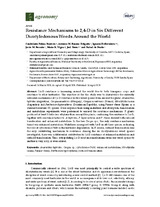Resistance Mechanisms to 2,4-D in Six Different Dicotyledonous Weeds Around the World
Autor
Palma-Bautista, Candelario
Rojano Delgado, Antonia M.
Dellaferrera, Ignacio
Rosario, Jesús M.
Vigna, Mario R.
Torra, Joel
Prado, Rafael de
Editor
MDPIFecha
2020Materia
Amaranthus hybridusConyza sp.
Cytochrome P450
Enhanced metabolism
Hirschfeldia incana
Papaver rhoeas
Parthenium hysterophorus
Reduced translocation
METS:
Mostrar el registro METSPREMIS:
Mostrar el registro PREMISMetadatos
Mostrar el registro completo del ítemResumen
2,4-D resistance is increasing around the world due to both transgenic crops and resistance to other herbicides. The objective of the this study was to characterize the currently unknown mechanisms of 2,4-D resistance in five weed species from around the globe: Amaranthus hybridus (Argentina), Conyza canadensis (Hungary), Conyza sumatrensis (France), Hirschfeldia incana (Argentina) and Parthenium hysterophorus (Dominican Republic), using Papaver rhoeas (Spain) as a standard resistant (R) species. Dose-response trials using malathion and absorption, translocation and metabolism experiments were performed to unravel the resistance mechanisms. R plants produced at least 3-folds less ethylene than susceptible plants, confirming the resistance to 2,4-D, together with resistance factors >4. A. hybridus, P. hysterophorus and P. rhoeas showed both reduced translocation and enhanced metabolism. In the two Conyza sps., the only resistance mechanism found was enhanced metabolism. Malathion synergized with 2,4-D in all these species, indicating the role of cytochrome P450 in the herbicide degradation. In H. incana, reduced translocation was the only contributing mechanism to resistance. Among the six dicotyledonous weed species investigated, there was a differential contribution to 2,4-D resistance of enhanced metabolism and reduced translocation. Thus, extrapolating 2,4-D resistance mechanisms from one weed species to another is very risky, if even related.

